A product has been added to the basket
Bullet Journaling For Beginners
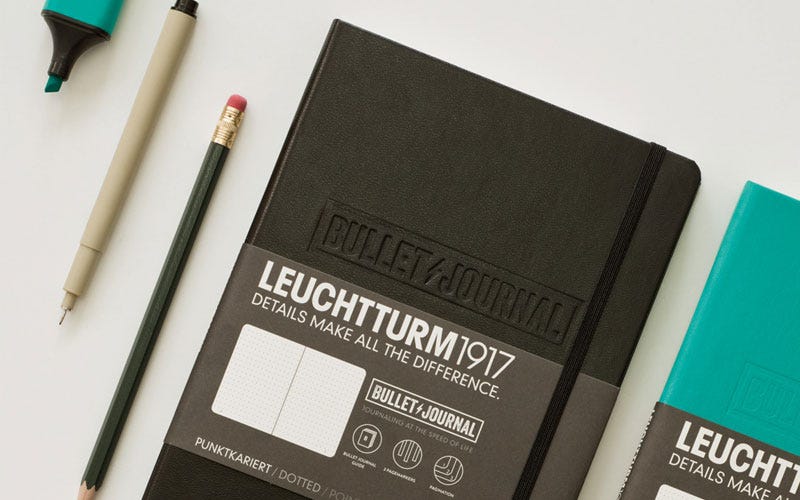
Bullet Journaling For Beginners
One of the newest products to our shelves, the Leuchtturm1917 Bullet Journal is a firm favourite of ours already. It’s because Bullet Journaling is different. Its unique system encourages brevity and creativity in every entry. 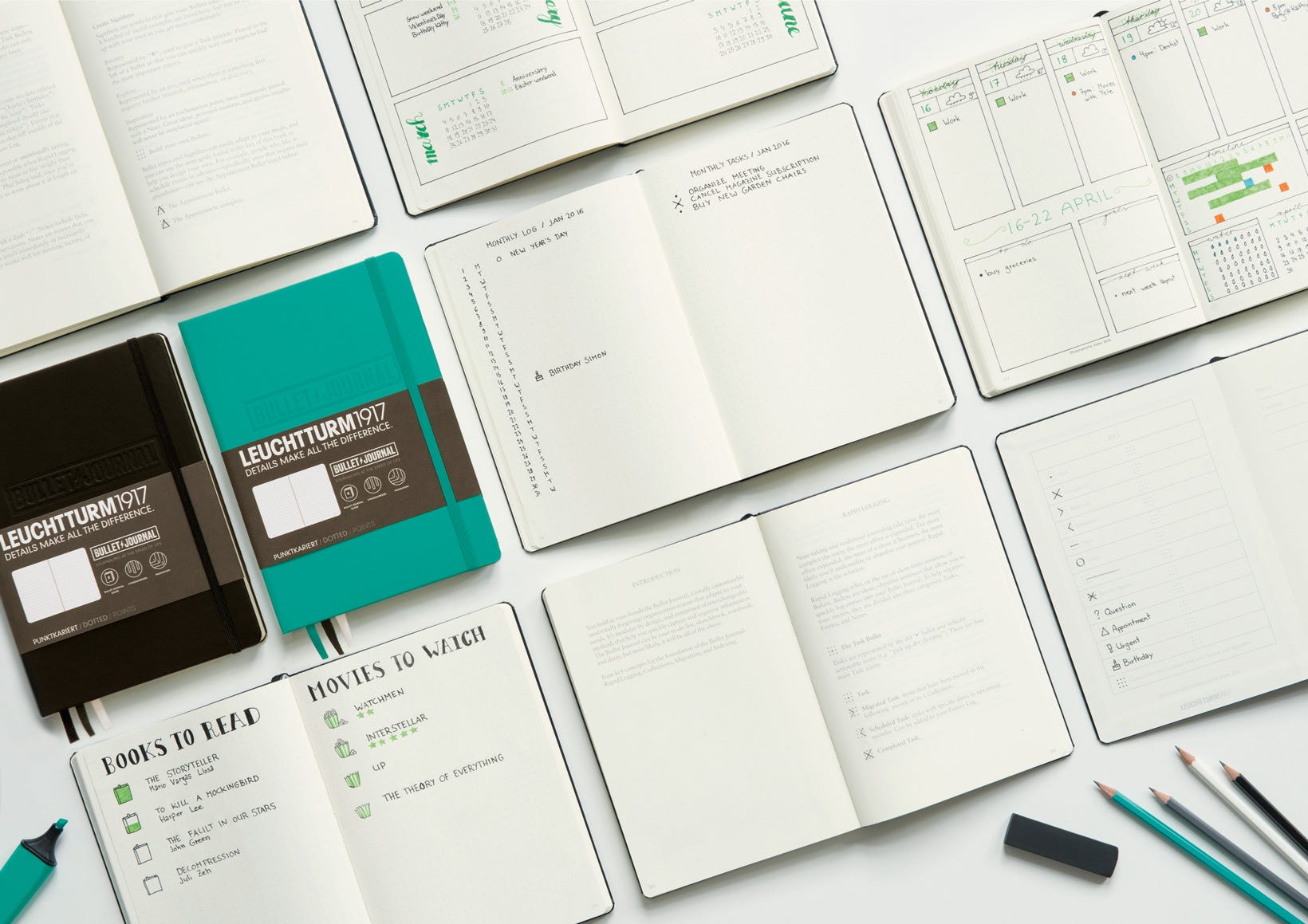
You may have heard about Bullet Journaling when you’ve been browsing all your favourite stationery websites. Or seen the gorgeous spreads Bullet Journalers post to Twitter and Instagram. But it’s not exactly clear what it entails.
“So what is a Bullet Journal?” I hear you say. “How does it work?” “And how can I get started?”
In part 1 of our 2 part series, we’ve explored the whats, and hows to bring you a beginner’s guide to Bullet Journals. All because we wanted to show you how to become a BuJo hero too.
Part 2 explores the whys - with interviews with from Bullet Journal enthusiasts and bloggers. Plus, their handy hints and tips.
WHAT IS BULLET JOURNALING?
Developed by Ryder Carroll, a digital product designer living in New York, simply put a Bullet Journal is a notebook. But it’s all your notebooks and diaries and planners in one. Ryder explains:
"I wanted to figure out a way for me to be able to capture whatever I was thinking, however I was thinking it and still house it in a way that was organized and easily accessible" 1
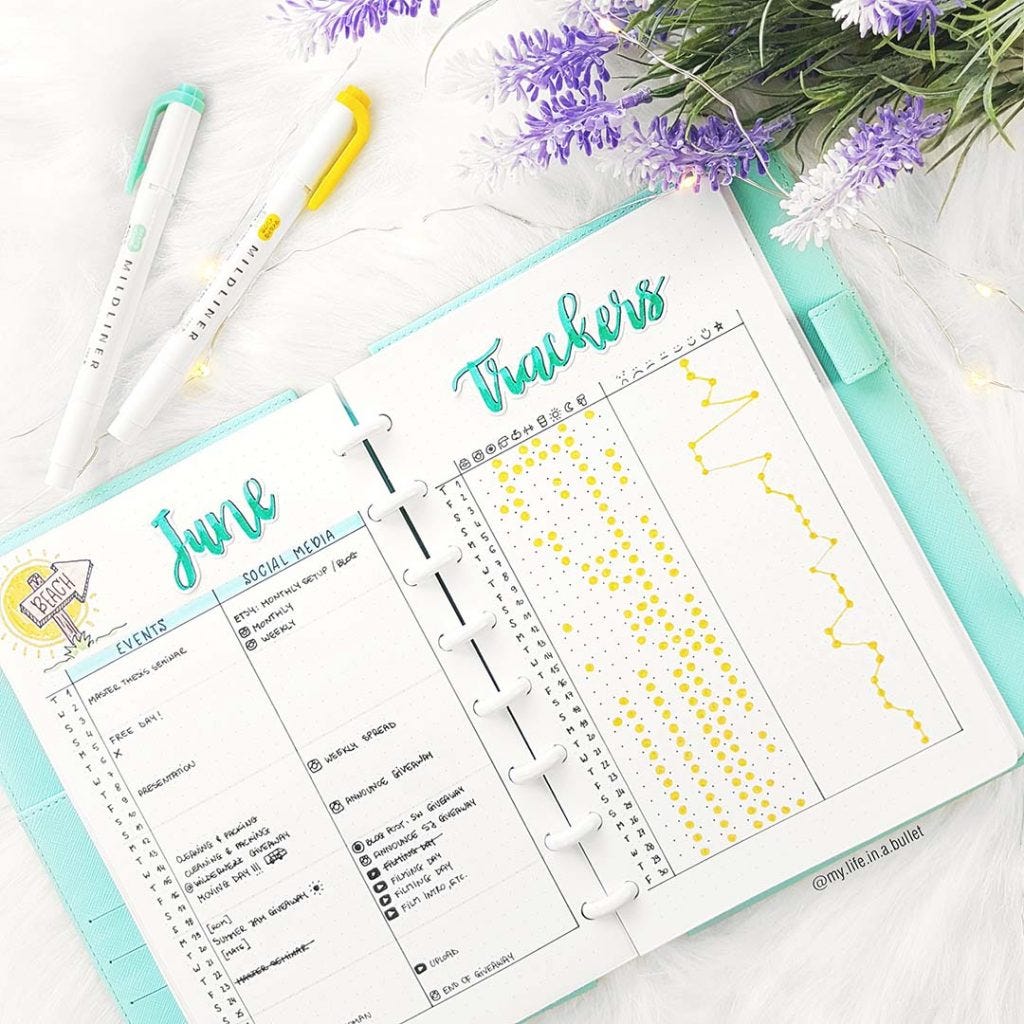 My Life in a Bullet's June Calendar & Tracker
My Life in a Bullet's June Calendar & Tracker
It’s the system for turning a simple notebook into the only planner you’ll ever need that’s so ingenious and has garnered such a cult following in relatively little time.
Called ‘Rapid Logging’; which makes it sound far harder than it actually is; the system uses different shaped bullet points to order and organise brief notes. Hence the name ‘Bullet Journaling’. So instead of a sentence you’ll write a couple of words, saving time and ultimately meaning you’re more likely to stick with this kind of journaling.
It can be a planner, a to-do list, a diary, a birthday calendar, a fitness record, a mood map, a wellness chart… the list goes on and on. The only limit is your imagination. Because of this it’s a great way to keep organised. 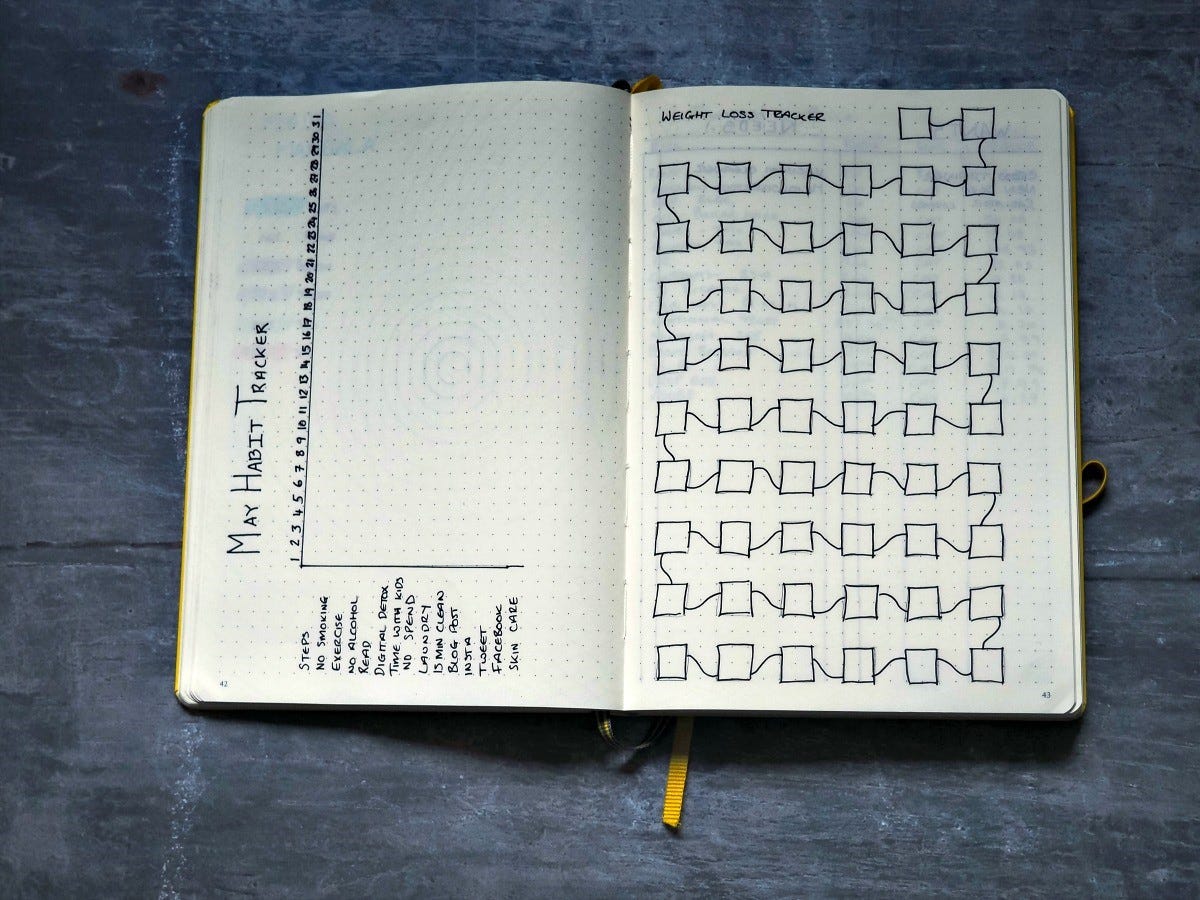 Pushing the Moon's Weight Loss Tracker
Pushing the Moon's Weight Loss Tracker
Most people use notebooks with dot grid pages. This allows flexibility to use the journal pages both in landscape and portrait, plus you can use the dot grid as a guide to ensure everything stays neat. The Leuchtturm1917 Bullet Journal has pages of dotted paper. But essentially you can use any notebook you like; the official Bullet Journal website suggests to pay attention to size and quality.
“If it’s too big you’ll never take it with you. If it’s too small it will be impractical. Be sure to get something that’s rugged enough to keep up with you.”
So pick up your notebook and pen and let’s get started…
THE BULLET SYSTEM
The bullet system created by Carroll is really simple to follow and can be tweaked to suit you.
The original method recommends you start by numbering and titling each page. If you use the Leuchtturm1917 Bullet Journal, you won’t need to number your pages as this is already done for you. A title can be the date if the page is for a single day or it can be a brief overview of the information. This means you can put all the pages into an index and quickly find information at a later date.
THE BASIC BULLETS
An event is represented by an open circle ∘ bullet. These are date related items which can be logged in both before as a reminder for on the day (Eg. ∘ Ryan & Laila 2nd anniversary) and after for a future reminder (eg. ∘ Moved house)
A to-do or task which you need to carry out is represented by a simple dot • (eg. • Call mum). You put this in your journal as a planned to-do and can be updated by drawing over the original bullet. 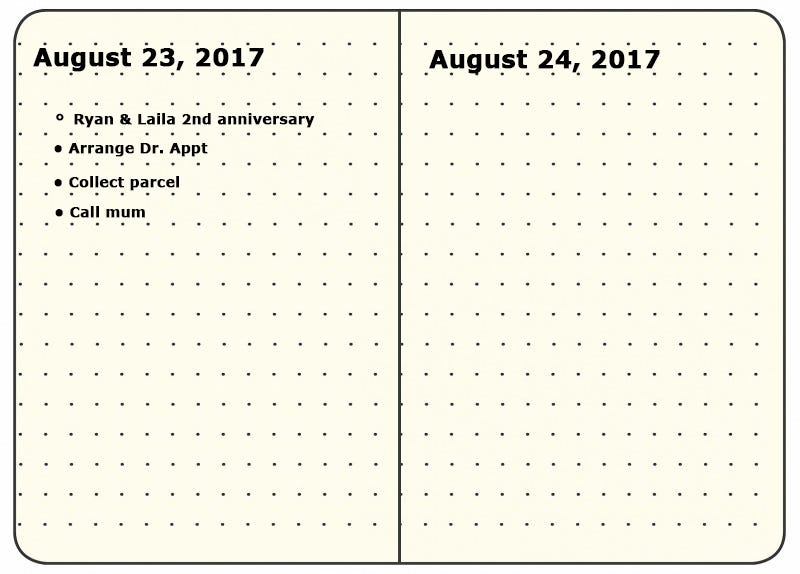 There’s 3 additional bullets states for a standard to-do:
There’s 3 additional bullets states for a standard to-do:
X – Task Complete
> - Task Migrated : This means that you’ve moved the task to another day/month/year
< - Task Scheduled : This means you’ve booked in an upcoming task, but it won’t be carried out till a later date. You can start a to-do as a scheduled task if you’re planning ahead or you can change a to-do from your list.
Eg. Your original bullet says: • Arrange Drs Appointment
Once arranged you can change the bullet point to: < Adding additional info if needed: < Arrange Drs Appointment – Aug 24. 1pm.
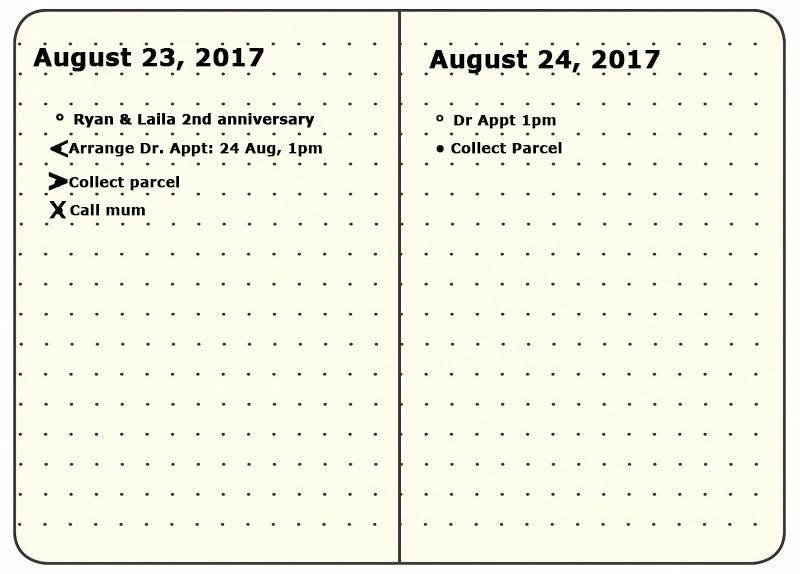 Due to the Rapid Logging system, all notes should be kept as brief as possible. So even if the particular event is very emotional or personal, keep it short. You can write about the event in length later on if you wish.
Due to the Rapid Logging system, all notes should be kept as brief as possible. So even if the particular event is very emotional or personal, keep it short. You can write about the event in length later on if you wish.
Notes are shown using a dash ‐ . Notes are things that you want to remember, but are not actionable like to-dos. These can be thoughts you had, facts you’ve heard or anything else in between really.
Eg. ‐ Bank holiday on Monday Or ‐ Talked to A about new workout
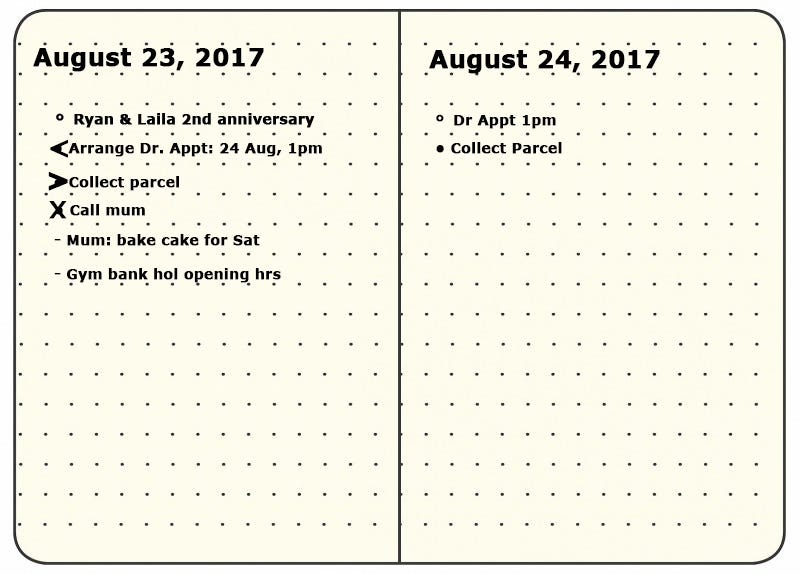
SIGNIFIERS
Don’t forget to add your signifiers – these are additional symbols that help you know what the most important task on your list is or what needs further work.
Signifiers are usually placed before the bullet and we recommend adding some colour or highlighting to make them stand out.
⁕ - Priority Task : These are your most important to-dos and you should try to do them first
! - Inspiration : Used for when inspiration has struck and you never want to lose that precious thought again. Ensure you know how profound it was by marking the note.  - Explore : An eye means you need to look into something further. Perhaps do some research on the topic before you can turn it into an actionable task.
- Explore : An eye means you need to look into something further. Perhaps do some research on the topic before you can turn it into an actionable task. 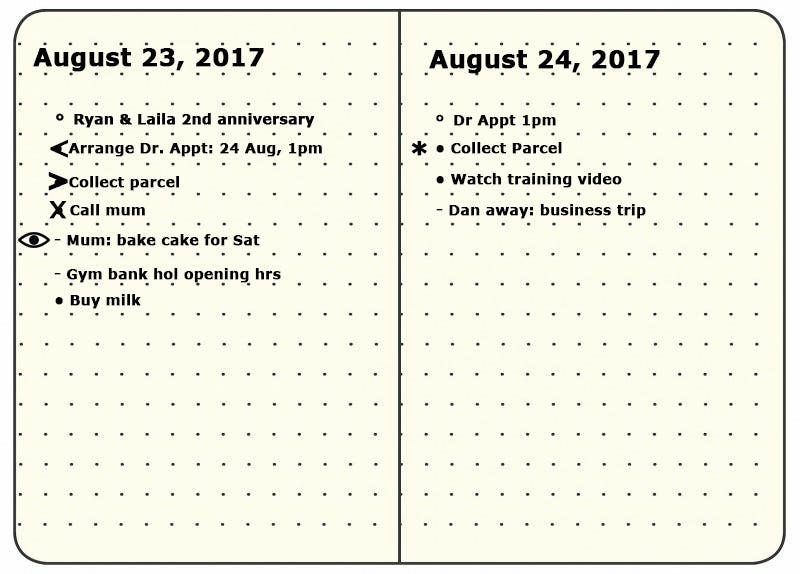
MODULES
A module organises your bullet points and gives you a theme to work on for that page or spread.
Most Bullet Journals start with a ‘Future Log’, which is just a fancy way of saying yearly calendar. This provides an overview of your year and is mainly reserved for big stuff, like birthdays and travel plans. 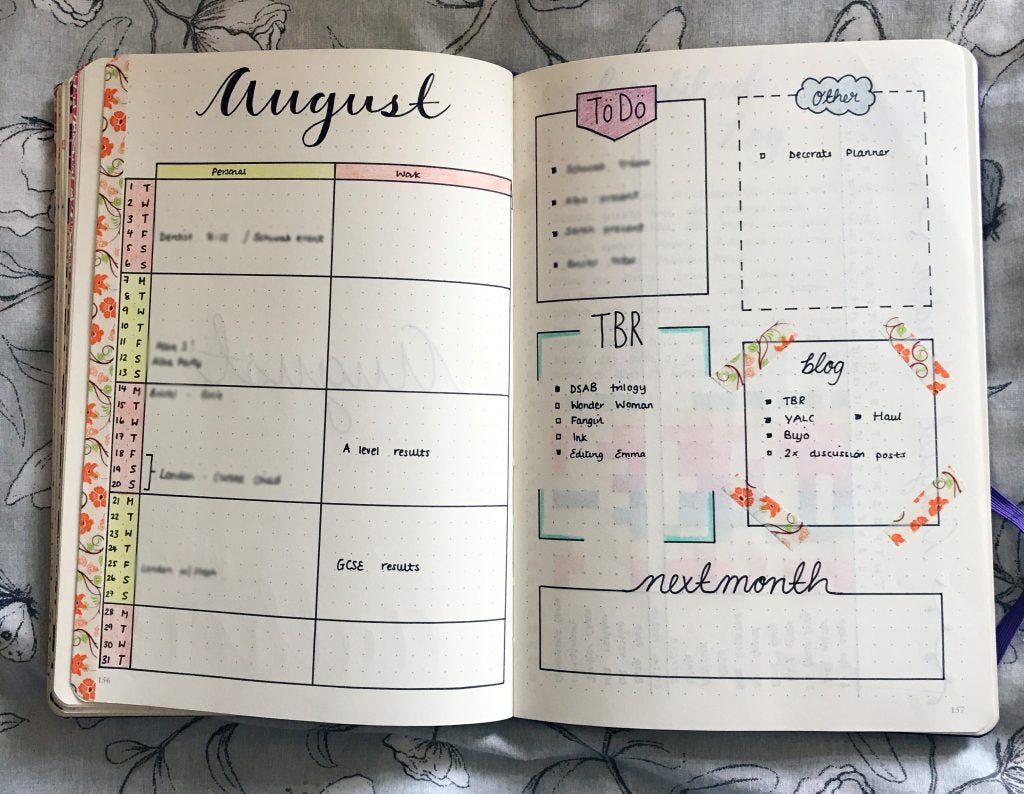 August Monthly Spread from Kelly's Ramblings
August Monthly Spread from Kelly's Ramblings
The natural progression here for most Bullet Journalers is a monthly overview module. A two page spread dedicated to a monthly calendar and tasks list. This helps keep organised at a glance. The quickest way to do this for beginners is to have the calendar page on the left with numbered dates down the left hand side of the page and a To Do heading on the right hand page; ready for your bullets.
These pages are where your Rapid Logging really comes into its own as you can migrate and schedule to-dos on one month and then easily move to another month or date later on. When you build your module pages for the new month you can check back to last month and move across what you need to.
You can use a monthly calendar layout to log a certain item everyday eg. your daily gratitudes or you can have an overview calendar which logs all items you want to keep track of for the whole month. 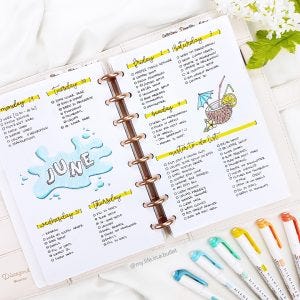 My Life in a Bullet - a weeks spread |
Pretty Prints & Paper's Activity & Habit Tracker Break up the year as much as you need, maybe into weekly spreads or individual days. Just make it so that the journal works for you. |
And that’s it. Easy Peasy!
Once you’ve got to grips with bullet journaling, check out our blog post on how to jazz up your journal. Adding some colour and design will help you be more creative and make your pages really stand out.
Check out our next blog post with Hints & Tips from Bullet Journal Bloggers.
1– Taken from an Interview with Ryder Carroll with CNBC.










Comments
Hey there, You have done a great job. I will certainly digg it and personally recommend to my friends.
I am sure they will be benefited from this web site.
Hey there, You have done a great job. I will certainly digg it and personally recommend to my friends.
I am sure they will be benefited from this web site.